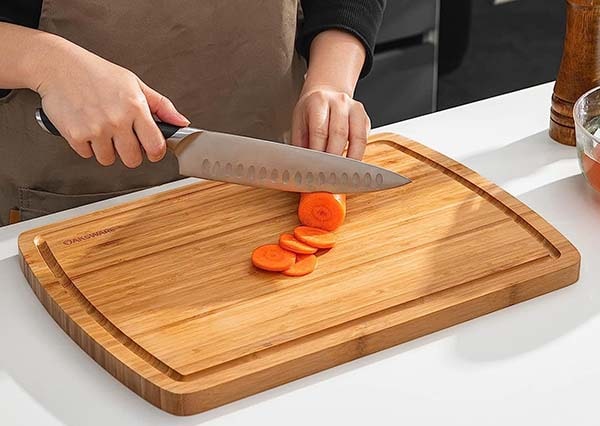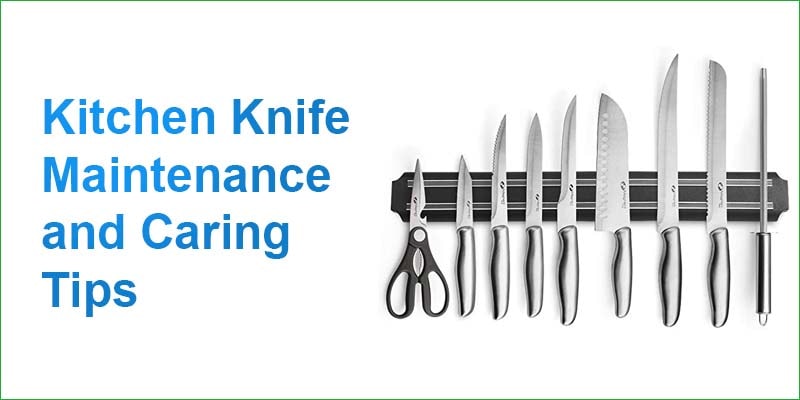If you are the new owner of a high-quality set of kitchen knives, you may find yourself lost as to how to properly maintain and care for them. In this article, I will highlight all of the steps necessary to keep your knives sharp and clean, ensuring they remain a useful part of your kitchen utensils supply for as long as you need them.
Also, if you are interested in a highly informative and dedicated kitchen knives review blog then visit TheIdealGoods.com
With the proper care and maintenance, your kitchen knives have the potential to last a lifetime. Follow these guidelines for all you need to know about the usage, cleaning, storage, and more of your kitchen knives.
Please note that lower quality knives may not last as long as higher quality knives, even if you follow these guidelines to a tee.
Overview of Kitchen Knife Maintenance Tips
- Use the right knife for the job
- Never use a knife without a cutting board
- Wash your knife by hand
- Never leave water or food residue on your knife
- Store your knife either on a magnetic bar or in a knife block
- Sharpen your blade only when necessary
- Carbon steel knives require special care, such as oiling
Use the Right Kitchen Knife for the Job
Before using your kitchen knives, you should be sure to select a knife that is made for the specific task you are using it for. For example, you should never attempt to slice meat with a bread knife or a vegetable knife. Attempting to do so can cause irreversible damage to the blade. In that case, you should use the best quality gyuto knife for that particular chore.
A kitchen knife should be cut with very minimal pressure, so if you find yourself using a lot of pressure in order to perform the cut, you may need to sharpen your blade or use a different type of knife.
Never Use a Kitchen Knife Without a Cutting Board
You should always use a cutting board under your knife when you are performing a cut. If you cut on a hard surface such as a marble countertop, you risk damage to your blade. The best material to use as a cutting board is a wooden cutting board. The wood will provide a base firm enough to allow for a clean-cut, but soft enough to protect the integrity of the knife.

One tradeoff of using a wooden cutting board is that it can be difficult to clean due to the indent knives leave on the surface. Be sure to thoroughly wash these cutting boards to avoid the growth of harmful bacteria. Although they may be easier to clean, never use glass or metal cutting boards as they can drastically reduce the lifespan of your knife.
A plastic cutting board could be a good alternative to a wooden cutting board but must be soft enough to not be too abrasive to the knife blade.
Wash Your Kitchen Knife by Hand
Kitchen knives should always be washed immediately after use. Never ever leave your stainless-steel kitchen knives in the sink after using them. Knives are sensitive to water and another residue should be left on the blade for an extending period of time. Water can cause rusting to occur and food reminisce can cause staining.
The best method of cleaning your knife is by hand, not in a dishwasher. Dishwashers are not recommended because it allows the knife to remain dirty and wet for a long amount of time after use. In addition to the risk of rust and stain, dishwashers also can cause damage to your knife by means of intense heat during the wash cycle.
For all of these reasons, it is recommended that you wash your knife by hand. Immediately after you use your knife, you should first rinse the blade with lukewarm water. After all food residue has been removed, take a gentle dish cleanser and sweep the blade with a soft sponge.
Never use a metal sponge cleaner on a knife, as it can scratch and damage the blade. Harsh detergents can sometimes cause rust or damage to the blade or handle, so gentle soaps are often better for the maintenance of your knife.
After washing the knife, do not leave any water on the blade. You should take a cloth or a paper towel and carefully dry the blade until it is completely dry. Once the knife is clean and dry, you should return it to the storage, following the guidelines below for proper and safe storage of your kitchen knives.
Perfectly Store Your Kitchen Knife
The most important rule to follow when it comes to the storage of kitchen knives is that the knives should never be stored in a drawer where they have the potential to come in contact with other utensils. Not only can the rubbing between utensils cause damage to both parties, but this method of storage is also a danger to any person looking to remove the knife or other utensils from the drawer. A sharp, uncovered knife can easily cause a skin wound if a person glides their hand along the blade by accident.
If a knife comes with a sheath, storage in a drawer may be an option. The sheath will prevent injury and the scraping of the blade against other utensils. A more preferable method of knife storage is on a magnetic bar or in a knife block. A magnetic bar can be placed on a kitchen wall, allowing for the display of the knives. This display can be helpful in situations with young children who can reach drawers but not up to the wall, and also if you wish to display the knives as a part of your kitchen aesthetic.
A knife black is another option that allows for knives to be safely and properly stored. Knife sets will often come with a block for storage, and sometimes these blocks will contain built-in sharpeners to keep your knives in good condition. Storing your kitchen knife in a knife sheath or a magnetic knife rod or a knife block would be the best idea. The decision of how to store your kitchen knives depends on a variety of factors, and you should carefully consider which option works best for you.
Sharpen Your Blade Only When Necessary
When you sharpen your kitchen knife, you are creating a new edge of the blade by scraping away at the existing edge of the blade. This process removes matter from the knife, and for this reason, should only be done when needed.
Sharpening your blade too often can lead to a decreased lifespan of blade. When you realize that your blade has become too blunt to easily slice through the material, you should begin the process of blade sharpening. To do so, you need a manual or electric knife sharpener or a sharpener rod, or a knife sharpening system. There are many YouTube videos available to guide you through the process of using the sharpener.
Depending on the specific tool you use, you will likely need to run the blade along with the sharpener, applying a gentle amount of pressure to the knife. By clicking here you will find different types of sharpeners to buy on Amazon. Your own experience with knife sharpening and your knowledge of the process should guide your decision regarding which device to use.
Carbon Steel Kitchen Knives Require Special Care
Some of the best Japanese chef’s knives like Sushi Knife, Santoku Knife, Deba Knife, Guyto Knife, Nakiri Knife blades are made of carbon steel alloy. Carbon steel kitchen knives require slightly more maintenance than stainless steel knives. However, proper care of these knives allows for a longer-lasting, higher-quality knife.
As carbon steel blades age, they go through this process called patina, which comprises the blade dulling. This process occurs naturally and protects the blade from rust. You should not try to scrub away the darker color of the patina occurring on the blade.
One unique care tip for carbon steel knives is that you should oil your knife regularly between uses and before you put the knife away in storage. You can use cooking oils or other types of oils. The frequency with which you use the knife determines how often you need to oil the knife. Everyday use lends to everyday oiling, and if you only use the knife rarely you should only oil every few weeks. To oil the knife, pour some of the oil onto the blade and rub it in with a cloth, being sure to avoid cutting your hand on the sharp part of the blade.
Another tip for the care of carbon steel knives like the high-quality sushi knives is to avoid using the knife on materials of high acidity like lemons and onions. The acidity of these foods can cause the blade to rust quickly. So, if you must cut these foods with a carbon steel knife, be sure to clean the blade very often. Knife storage and cutting methods are overall the same for both carbon steel and stainless-steel knives.
Final Notes
I hope that this article was able to bring you some insight as to how to properly care for and maintain your kitchen knives. By following these guidelines of usage, washing, storage, and sharpening, you should be successful in maintaining the integrity of your knife for a long time. I encourage you to further explore online resources regarding the maintenance of your knives and other kitchen materials and wish you luck in your kitchen-related endeavors.
